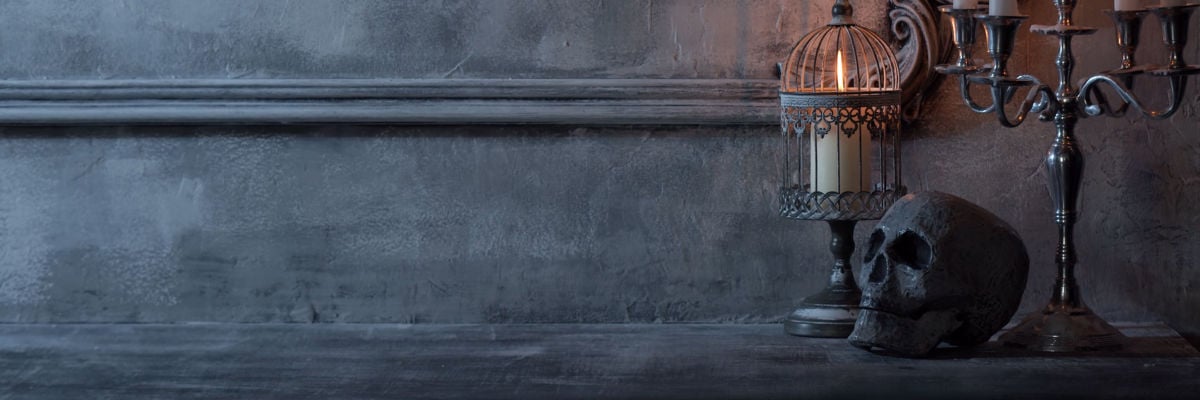
This week begins the Church’s month of the dead. We remember those who have died, and this should stimulate us to keep our own deaths in mind. With All Souls’ Day approaching, I wish to focus on the latter activity: the remembrance of death, associated with the artistic theme of the memento mori, a visual reminder of death.
What Is Memento Mori?
Memento mori literally means “remember” (a command) “to die” (an infinitive)—that is, “remember that you, the onlooker, will die.” It is a pithy restatement of the words of the priest who places ashes on the foreheads of the people on Ash Wednesday: “Memento homo quia pulvis est et pulverem reverteris.” (“Remember, man, that you are dust, and to dust you shall return.”)
Memento mori images are found not only on tombs and gravestones, but also in association with the memorial plaques found in Catholic (and Episcopalian) churches: a human skull or skeleton, mournful angels with inverted torches, hourglasses, and the like. These even found their way onto liturgical vestments, until the Church forbade this, since only images and symbols of holy things should decorate vestments. Death is important—worthy of respect, indeed—but it is not a holy thing. It is, indeed, our enemy: “The last enemy to be overcome is death” (1 Cor. 15:16)—the only quotation from Scripture found, interestingly enough, in the Harry Potter books.
The Four Last Things: Death, Judgment, Hell, and Heaven
The Four Last Things—death, judgment, hell, and heaven—used to be a regular subject for preaching and pious meditation. This preaching stopped abruptly in modern times. In a recent book review of How Our World Stopped Being Christian, by the French sociologist Guillaume Cuchet, John Pepino writes:
The sudden silence in the pulpits (as tracked in parish bulletins giving the topic of the homily) regarding the four last things . . . gave the impression that the clergy had either ceased to believe in them or no longer knew how to discuss them, even though these had been frequent sermon topics right up until the [Second Vatican] Council.
The discontinuity in the preaching is one problem—Pepino notes “changes in official teaching” that turned “humble folk into skeptics”—but there is also the question of the intrinsic value of the new approach. The Council did not, in fact, tell priests not to preach about mindfulness of death. Even if we think pre-conciliar preaching was too gloomy (an academic question for me and most readers, too young to have experienced it), it has become evident that always looking on the bright side does not in itself ward off all our problems—and certainly not the problem of death.
The Modern Attitude Toward Death
It is no coincidence that an era that ignores or mocks the idea of spiritual preparation for death, marking death, and mourning it is an era in which death is difficult to discuss. Death today is an embarrassment. Instead of visiting the dying, comforting them, and praying with them, they are commonly sedated: I understand from priests involved in hospital-visiting that it is now rare to be able to give the last rites to a conscious patient. Instead of entrusting the bodies of dead loved ones to the earth and visiting and tending their graves, it is now more common to make them disappear altogether, by burning them and scattering the ashes. (It is worth noting that while cremation is now permitted by the Church, the scattering of ashes is not.)
As Shakespeare wrote, “all that lives must die, passing through nature to eternity” (Hamlet, Act 1, Scene 2). Even those alive at the Second Coming will pass through death: it is the doorway to eternal life. It is also the final moment of decision, the final moment in which we can influence our eternal fate.
This might seem unfair, and many modern speculations about the afterlife try to do away with the possibility of damnation (by saving or annihilating the damned), or indefinitely extend the time in which we can make morally significant choices (by reincarnation). Such theories rob life of its significance. This is the time of action: it is what we do now that matters, and it matters a great deal: “the night cometh, when no man can work” (John 9:4). If it doesn’t matter very much, or at all, we might as well not bother.
Memento Mori in Christian Art and Symbolism
If death is important, we need to prepare ourselves for it, and we can do that only if we allow ourselves to think about it. A long artistic tradition seeks to remind us of death through painting and sculpture. Some of it may seem a bit gruesome for modern tastes, but the grim reality of death can’t be brushed aside forever. The meditation on death to which this invites us is not an invitation to despair and passivity; rather, it should be a stimulus to renewed effort, to make the most of the life that God has granted us.
Indeed, to make the most of life, bearing in mind the reality of death, is not to close our eyes to death and have as much fun as possible—often at the expense of other people. It is rather to follow the advice of St. Paul: “Let us not tire of doing good” (Gal. 6:9).
The Historical Significance of Memento Mori
It is in this spirit that paintings of the saints sometimes include a skull sitting on a desk: they are depicted as having a memento mori, as many pious persons did. It is a custom we would do well to revive, at a time when people behave as if they were immortal, and then find it difficult to face their own death, or to accompany another through the final stage of life.
An even better way of remembering death, though, is to remember the dead, observing a period of mourning for deceased loved ones—not of gloom, but of remembrance and prayer. As Hamlet bitterly remarks of his mother’s truncated remembrance of her husband, “there’s hope a great man’s memory may outlive his life half a year” (Act 3, Scene 2).



